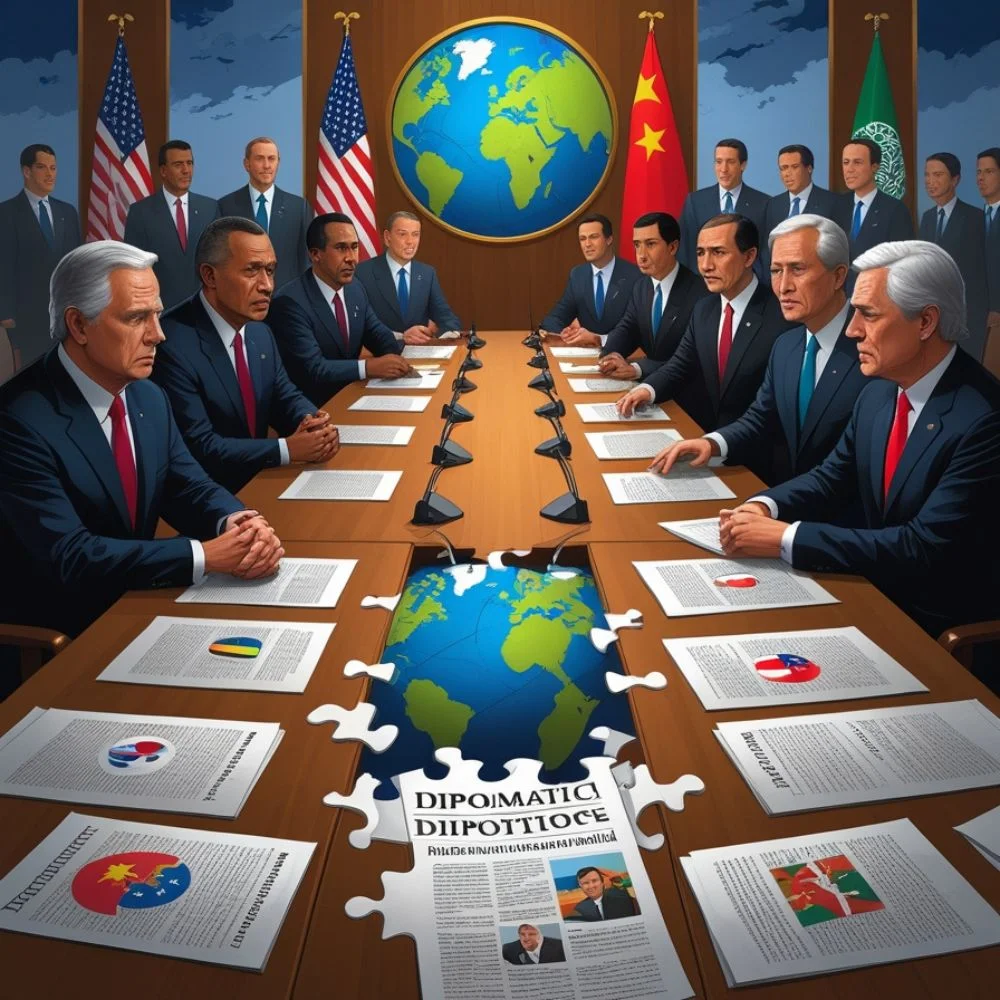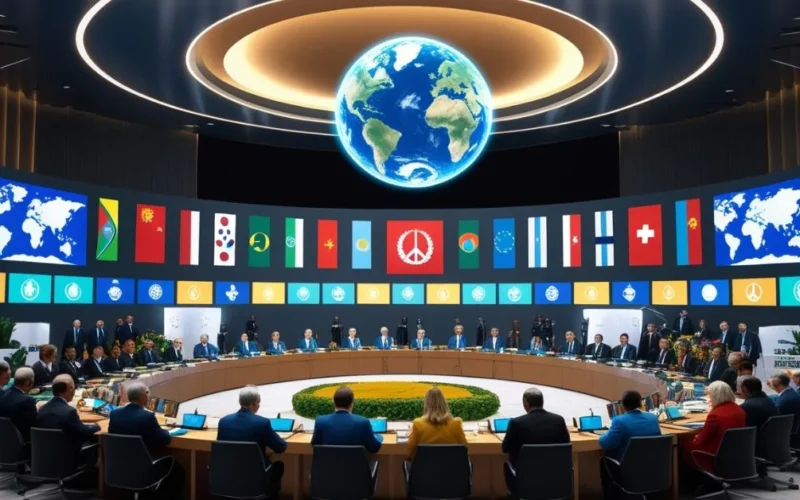Table of Contents
- Introduction
- What Is International Diplomacy?
- Why Are Diplomacy Summits Important?
- Types of Diplomacy Summits
- How Diplomacy Talks Are Organized?
- Key Organizations in Diplomacy Summits
- Top Issues Discussed in Diplomacy Talks
- Successful Examples of Diplomacy Summits
- Challenges in Diplomacy Talks
- Role of Diplomats and Foreign Ministers
- Digital Diplomacy and Virtual Summits
Introduction
International diplomacy summits and talks bring together leaders from different countries to solve global problems, create agreements, and build peaceful partnerships. These meetings influence the world’s political and economic direction. Whether it’s climate change, trade negotiations, or conflict resolution, diplomatic talks have become a crucial part of international relations. In this article, you’ll learn what diplomacy means, how summits function, and why these talks are important for every nation.
What Is International Diplomacy?
International diplomacy happens when countries communicate directly to manage global challenges and promote peace. Instead of using force, they sit down and talk. As a result, they avoid war and build cooperation. Countries practice diplomacy to:
- Sign agreements on trade, defense, or climate
- Avoid war through peaceful negotiations
- Strengthen global friendships
- Defend human rights and enforce international laws
Usually, diplomats, foreign ministers, or presidents handle these responsibilities. Their goal is to serve their country’s interests while also respecting other nations’ views. Therefore, diplomacy builds understanding and cooperation, even during difficult times.
Why Are Diplomacy Summits Important?
Diplomacy summits give leaders a chance to speak face-to-face. As a result, this direct communication builds trust, speeds up problem-solving, and reduces misunderstandings. Moreover, these meetings often lead to:
- Signed deals and formal treaties
- Joint action on global challenges like climate change and terrorism
- Peace discussions between opposing nations
- Better international partnerships
In today’s world, where nuclear weapons, cyberattacks, and pandemics are real threats, communication and cooperation matter more than ever. Consequently, these summits have become a key tool for global peace and progress.
Types of Diplomacy Summits

Summits come in different forms depending on who attends and what issues they address. Let’s look at the main types:
1. Bilateral Summits
These involve only two countries. For instance, when the U.S. and China meet to resolve trade issues, it’s a bilateral summit. These meetings tend to be more focused and usually result in specific agreements. Additionally, they can quickly address urgent matters between the two nations.
2. Multilateral Summits
Multiple countries participate in these talks. Events like the G7 or the UN General Assembly fall into this category. They handle broad topics such as health, climate, and peace. Moreover, they often include long-term planning for global goals.
3. Emergency Summits
Nations organize these summits when fast decisions are needed. For example, leaders may meet urgently during wars, pandemics, or natural disasters. In such situations, quick coordination and support are vital. Therefore, emergency summits focus on fast, actionable solutions.
How Diplomacy Talks Are Organized?
A lot of planning goes into setting up a summit. Every step counts to make sure talks go smoothly. Here’s how the process typically unfolds:
- Pre-summit meetings: Diplomats discuss and finalize key topics ahead of time.
- Agenda setting: Leaders agree on what to discuss to stay on track.
- Venue selection: Organizers choose a safe and neutral location for fairness.
- Security and logistics: Teams manage travel, meals, safety, and translation needs.
- Press and communication: Media coverage is carefully planned, though some talks remain private.
Because of this detailed planning, countries ensure equal treatment and productive conversations during the summit.
Key Organizations in Diplomacy Summits
Several international organizations play leading roles in organizing or hosting global summits. Some of the most influential include:
1. United Nations (UN)
The UN hosts frequent meetings and is a global leader in peacekeeping and diplomacy. The annual General Assembly is a key event where all member nations speak. In addition, the UN supports smaller summits focused on health, development, or humanitarian issues.
2. G7 and G20
These two groups consist of the world’s largest economies. Their summits usually focus on economic growth, climate efforts, and financial stability. Moreover, they often agree on joint actions that influence global markets.
3. European Union (EU)
The EU holds regular talks between member states and also invites others to strengthen trade and political ties. Besides that, it sets rules that impact millions of people across Europe and beyond.
4. African Union (AU) and ASEAN
The AU and ASEAN focus on regional stability, development, and cooperation. Their summits aim to address local issues with unified solutions. Furthermore, they provide a voice to smaller nations in regional matters.
Top Issues Discussed in Diplomacy Talks
World leaders use summits to talk about urgent global topics. The most frequently discussed issues include:
- Climate change: Countries negotiate emission targets and green energy plans. As global temperatures rise, these discussions are more important than ever.
- Trade pact: Talks often help reduce violence or end long-standing wars. Consequently, they can bring hope to millions affected by conflict.
- Health crises: Global pandemics like COVID-19 push nations to act together. These talks allow for faster, more united responses.
- Cybersecurity and AI: Governments work on rules to control hacking and safe tech development. This is especially crucial as digital threats grow rapidly.
- Migration and refugees: They plan how to manage immigration while respecting human rights. In many cases, cooperation leads to safer migration processes.
All of these issues need teamwork. No country can solve them alone.
Successful Examples of Diplomacy Summits
Some summits have changed history. They show the real power of diplomacy:
1. Paris Climate Agreement (2015)
Close to 200 countries signed this agreement to fight global warming. It showed that diplomacy can lead to major environmental action. Even though some countries later withdrew, the agreement still influences climate policy today.
2. Camp David Accords (1978)
After years of war, Egypt and Israel reached peace thanks to U.S. mediation. This summit remains a symbol of successful negotiation. Since then, other countries have followed similar paths to peace.
3. U.S.-North Korea Talks (2018)
Though they didn’t result in a final deal, these talks marked a rare direct meeting between two long-time enemies. It opened the door to further discussion and reduced immediate tensions.
Challenges in Diplomacy Talks
Even though diplomacy has many benefits, it doesn’t always work perfectly. Countries face several common challenges:
- Lack of trust: Some nations doubt each other’s intentions. Without trust, agreements become harder to reach.
- Power gaps: Stronger countries might dominate weaker ones. This often leads to unfair deals.
- Domestic pressure: Leaders may avoid compromise to satisfy voters back home. Thus, talks can stall due to internal politics.
- Language and culture issues: Misunderstandings can slow things down or create conflict.
- Media leaks: If sensitive details get out, they can harm negotiations and damage relations.
Nevertheless, diplomacy remains a better option than conflict. Despite the obstacles, most countries continue to choose peaceful dialogue.
Role of Diplomats and Foreign Ministers
Diplomats serve as a country’s voice abroad. They work in embassies, build relationships, and prepare for high-level meetings. Foreign ministers lead the diplomatic team during summits. Their tasks include:
- Representing national interests clearly
- Writing or reviewing agreements
- Building networks with other nations
- Preventing disputes before they grow
As a result, skilled diplomats often prevent wars, open new markets, and support peaceful development, sometimes without public recognition.
Digital Diplomacy and Virtual Summits
Technology has changed how countries hold diplomatic talks. During the COVID-19 pandemic, most summits moved online. Digital diplomacy offers several benefits:
- Leaders can connect quickly without travel
- Meetings happen more often and save money
- Nations can respond faster to emergencies
However, building trust is harder over screens. Some sensitive matters still require face-to-face discussions. Still, virtual summits remain a helpful option in modern diplomacy. Additionally, digital tools now help monitor agreements and track global progress.




